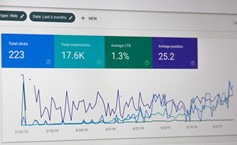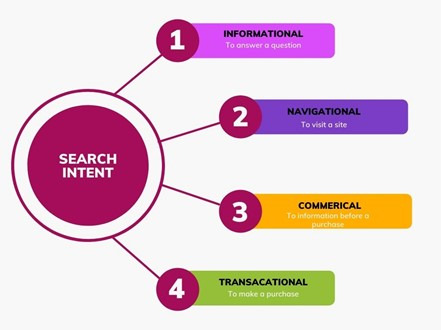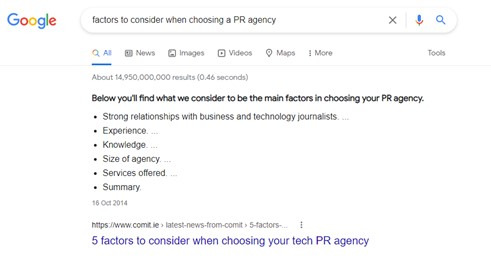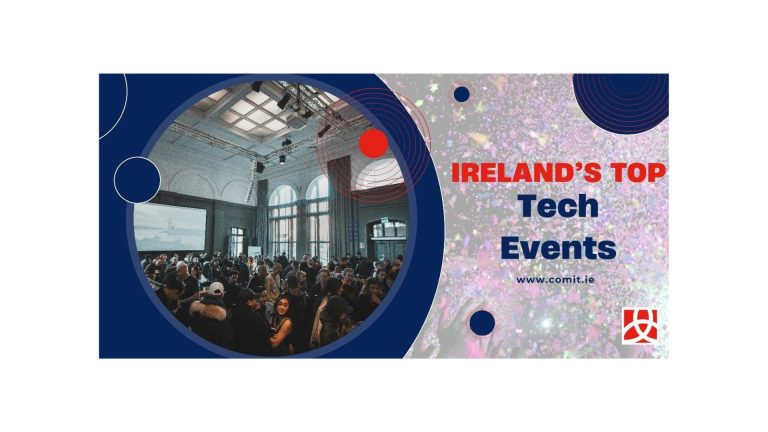Understanding how to maximise SEO is an essential part of any digital PR strategy. As the media landscape has become more digital, public relations and digital marketing activities have become intertwined. Blogging should be an essential element in this.
Writing and optimising blog content is a great way to inform your target audience, increase authority and improve website ranking. Here, we will explore the best ways to optimise a blog to boost search engine rankings for your webpage.
What is SEO?
 Search engine optimisation (SEO) is the practice of increasing a website’s organic traffic by boosting rankings on search engines such as Google. This increases the visibility of your brand, product or service when potential customers search for related keywords online. SEO promotes organic traffic, which, like PR exposure, is unpaid and not gained through advertising. This makes organic search one of the most effective ways to boost your brand online.
Search engine optimisation (SEO) is the practice of increasing a website’s organic traffic by boosting rankings on search engines such as Google. This increases the visibility of your brand, product or service when potential customers search for related keywords online. SEO promotes organic traffic, which, like PR exposure, is unpaid and not gained through advertising. This makes organic search one of the most effective ways to boost your brand online.
Understanding Search Algorithms
To understand how to improve SEO, we first must understand search engine algorithms. Search algorithms are designed to sort through the massive volume of information on the web to present searchers with the most relevant, useful and accurate results to answer their queries.
 We use search engines to find information on all sorts of things. Whether it’s for work, school, or to find the best restaurant in our neighbourhood, the one consistent thing is that we want accurate results – and fast. That is where the algorithm comes in. The algorithms are designed to provide what the search engine has decided is the most accurate information first.
We use search engines to find information on all sorts of things. Whether it’s for work, school, or to find the best restaurant in our neighbourhood, the one consistent thing is that we want accurate results – and fast. That is where the algorithm comes in. The algorithms are designed to provide what the search engine has decided is the most accurate information first.
Research in 2020 found that over 25% of people click on the first organic Google search result, dropping to 15.7% for the second and 11% for the third. Therefore, in order to maximise visibility, you should aim to rank in the top three search results, ideally at number one.
Understanding how algorithms work will help you get the basics right and understand how to optimise content to rank high in search results. For the purpose of this blog, we will look at the Google algorithm, as Google is the most widely used search engine worldwide, holding 85% of the market share.
Google’s algorithm looks at a number of factors when choosing what content to present. It is highly complex, regularly updated and considers hundreds of factors to rank content. However, there are a number of key elements to be aware of.
1. Search intent
To understand what information to show first, Google will look at user search intent – in other words, what the searcher wants to find. To do this it takes into consideration the language used, explores synonyms and also looks at whether the query is very specific or broad.
There are four types of user search intent.

Informational – Searching to answer a question – e.g. “What is PR”
Navigational – Searching to visit a specific site – e.g. “Twitter.com”
Commercial – Searching for information before a purchase – e.g. “Best Dishwashers 2022”
Transactional – Searching to buy something e.g. “Bosch series 2 Dishwasher”
2. Relevance of webpages
The algorithm also analyses the content of web pages to find which is most relevant by looking for matching keywords. If keywords feature on the page or in the headings, the content is likely relevant.
However, the algorithm is much more complex than simply matching keywords: it will also attempt to understand the meaning or topic of the text as a whole and how it relates to the specific search query to find pages that are most likely to address the question. Therefore, simply repeating keywords is not enough to boost a blog post’s ranking.
3. Quality of content
The goal of a search engine is to present information that is most likely to provide the answer that the searcher is looking for. Therefore, it will prioritise the most reliable sources and sources with high-quality content. In order to rank high on Google, you must publish high-quality content that is well researched, well written, and informative.
Sites with authority and expertise, which are viewed by Google as trustworthy, are likely to rank highly. These factors are based on engagement from other users, as well as links from other reputable sites. This is one area where we see the value of PR, as Google ‘likes’ companies that have been written about by media publications.
4. Usability of webpages
To ensure the most user-friendly experience – and that users continue to use Google – the search engine favours websites that are easy to use. At the most basic level, before you begin to optimise content on your webpages, you need to ensure that your website is running correctly and that all bugs are fixed as they arise. The algorithm looks at factors such as device accessibility, page loading times and browser compatibility and will rank the best pages first.
5. Context and settings
Again, to create a user-friendly experience, Google provides personalised search results based on information such as location, search history and settings. Therefore, if you are based in Ireland and you search for the term ‘best PR agency in Ireland’ you are likely to yield results of PR agencies based in Ireland.
Why is blogging good for SEO?
Ultimately, the more relevant content you post, the more opportunities there are for customers to find your web page.
As we established earlier, Google’s algorithm looks at the searcher’s intent and matches it with the most relevant information. Suppose you are a business operating in a niche area, such as an IT recycling company. You will want your page to rank for very specific searches such as ‘IT recycling’ or ‘IT assets disposal’. Without blog content, there is less information on your website so it is unlikely that it will rank high for other related search terms.
If you create relevant blog content, you can provide information that will answer questions that your customers may be putting into their browser. This creates more opportunities for your content to be found, shared, and reach your target audiences.
How to improve blog SEO
Now that we understand how the algorithm works, we have established serval basic principles that are required for optimising blog content, such as using keywords, creating high-quality content, and ensuring your website is running correctly. Once these have been mastered, there are a number of additional tips and tricks you can incorporate into your blog strategy to boost your ranking and maximise online exposure.
How do I improve blog SEO?
1. Keywords
As stated previously, one way in which Google identifies relevant content is through keywords. Keyword research is therefore extremely important in any blog strategy. The aim is to choose terms and phrases that are relevant to your company and, importantly, are keywords and search terms that your customers use.
To identify the best keywords for your site you can carry out keyword research using a number of different online tools such as Google’s Keyword Planner, which allows you to discover new keywords, get insights into search volumes and estimate the traffic for keywords. The tool also helps to highlight lower volume keywords, which don’t have as much competition as other keywords but are still relevant and important to your company.
 Once you have selected your keywords, remember not to get carried away with them. Keyword Stuffing, where words are repeated unnaturally, will negatively affect your ranking position.
Once you have selected your keywords, remember not to get carried away with them. Keyword Stuffing, where words are repeated unnaturally, will negatively affect your ranking position.
2. Use related keywords
Related keywords, also referred to as semantically related keywords, let the algorithm know what your content is about and reinforces that the content is relevant. As mentioned above, overloading content with keywords will negatively affect SEO. Therefore, optimising your content for a topic by incorporating related keywords is much more valuable.
Related keywords ultimately provide more context and information on the topic you are trying to gain authority on. Not only are you letting the algorithm know what your content is about, but it is also more likely that your content will contain information that users are searching for.
3. Use listicles
Using listicles and bullet points is a great way to make your content user-friendly and easier to read. Content displayed in an organised manner is more digestible and scannable, making it more likely that users will engage with your content and stay on your web page for longer.
Your content will be easier to read for your audience, as well as for the algorithm. This will make your content more appealing for featured snippets. These appear at the top of the search results page on Google at ‘Position #0’. These are designed to quickly answer a searcher’s query without clicking on a webpage and usually consist of definitions, tables and lists.
Example of a featured snippet for the search term: factors to consider when choosing a PR agency.

4. Add visuals with Alt Text
Not only do visuals, such as images and videos, make your content more engaging and easier to read, but they also help improve blog SEO. They should add value by further explaining your content or presenting information in a digestible way that ultimately creates a better user experience. Images such as infographics and examples should always contain Alt text as they are being used to further explain the context of the text. However decorative images such as stock photos do not need Alt text descriptions as the information in the photo is irrelevant to the topic and will lead to keyword stuffing.
To optimise your images for search engines, you need to include images with alt text. Alt text explains to the algorithm what the image is about, as it cannot look at a photo the same way that we see it online. Alt Text is also important for screen reading software, so in general, it will make your content more accessible.
Alt text should be specific and descriptive and represent the topic that the webpage is discussing. Here are a few guidelines for writing strong Alt Text
- Use under 125 characters
- Describe the image and be specific to give as much context as possible
- Use keywords that are relevant to the image and avoid keyword stuffing
- Don’t start with “image of” or “picture of”
- Don’t add Alt text to decorative images.

Example of strong Alt Text for the above image:
Three technology PR professionals in front of a whiteboard, brainstorming for a survey on data breaches.
5. Optimise page title
Page titles are the first thing searchers will see when your webpage appears on the search engine results page (SERP) and, ultimately, this will be their first impression of your webpage. Your page title should be a short description of what your page is about and convey to users that your webpage contains the information that they are looking for.
While page titles have an indirect effect on SEO, they are still an integral part of a successful SEO strategy. To optimise your page titles for SEO, each page title should be unique, convey what the page is about and incorporate your keywords. Page titles should be between 30 to 60 characters and include both letters and numbers where possible. Keywords should be placed at the beginning of the tile where possible.
6. Optimise meta description
A meta description is a brief page summary that appears on the search engine results page (SERP) under your page title to give more context on what your page is about. Again, the meta description allows you to tell searchers why your content is relevant.
Meta descriptions should be around 50-160 characters in length, providing clear and concise information. Just like page titles, meta descriptions indirectly affect SEO as they impact a page’s click-through rate and drive traffic to the webpage, which will indirectly have a positive impact on SERP ranking.
7. Use internal and external links
Using internal links helps users and search engines to navigate your website. Internal links connect pages and posts in different ways. Navigational links, which relate to the technical structure of the website such as homepage tabs and titles, help you to move from one page to another. Contextual links, meanwhile, are embedded in the content of webpages to guide users to related content, provide more information on the topic and encourage readers to stay on your site for longer.
Similar to users, search engines also use links to crawl your web pages and find relevant information to present to searchers. If pages are not linked, then the search engine cannot find them and index them. Navigational links are absolutely necessary to guide users and Google to your pages on the most basic level, while contextual links help to reinforce that these pages are relevant and significant.
It is also valuable to include external links in your content. While this may seem counterintuitive as external links direct users to another website and away from your own, these links add value as they back up your information with authoritative and credible sources. This shows readers and Google that your information is well informed and that your site is a trustworthy place to seek information.
8. Publish long-form content
Research has shown that longer performs better in search rankings. That being said, the content should be high quality, well informed and provide value to the reader.
Long content is excellent for SEO as it allows you to position yourself as an expert in your field, providing informative and detailed information on industry topics. This can result in attracting links and becoming reference material for external content.
Longer content will naturally be more detailed and touch on several topic angles. Therefore, your content will be more likely to be relevant to more users and appear in more search terms.
According to HubSpot the ideal length for blog content is between 2,100 and 2,400 words. However, not all topics will warrant long blog posts, so it is essential to consider how valuable and useful the content is for readers.
Conclusion
While there are many things to consider when optimising content for SEO, the bottom line is that if you are creating blog content without SEO in mind, it is likely that it will get lost in the endless stream of online content.
Working with a specialist PR agency like Comit can help relieve some of the burden. Not only can we write blog content on your behalf, but we can also optimise and adapt the content for SEO and help boost your Google ranking.
Contact us today to learn more about how we can help with your blog and overall, SEO strategy!






